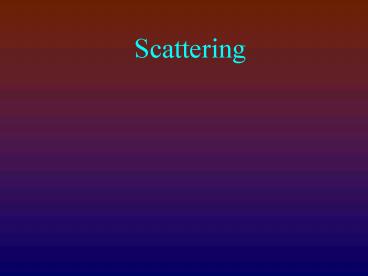Scattering - PowerPoint PPT Presentation
1 / 22
Title:
Scattering
Description:
directional scattering of light that shows a strong inverse relationship ... (c) senile miosis: reduces retinal illumination and increases scattering from the ... – PowerPoint PPT presentation
Number of Views:146
Avg rating:3.0/5.0
Title: Scattering
1
Scattering
2
Q1. The sky appears blue as a result of
- directional scattering of light that shows a
strong inverse relationship with frequency - non-directional scattering of light that shows a
strong inverse relationship with frequency - directional scattering of light that varies
exponentially with frequency - non-directional scattering of light that varies
exponentially with frequency
3
Q2. The colors of sunset in a non-polluted
atmosphere result from the fact that
- longer wavelengths scatter more in the late
afternoon - shorter wavelengths have been depleted by their
long passage through the atmosphere - longer wavelengths have been depleted by their
long passage through the atmosphere - chromatic aberration focuses longer wavelengths
at a greater distance from the source
4
Retinal Photocoagulation and Chromophores
Chromophores are molecules that absorb laser
energy (photons)
- Shorter wavelengths
- have higher photon energy and are more efficient
at heating target chromophores - do not penetrate as far through tissue
- elicit greater Rayleigh scatter
- Longer wavelengths
- are less efficient at heating target chromophores
- penetrate tissue to greater depths and may damage
underlying tissue - elicit less Rayleigh scatter
5
Larger particle (Mie) Scattering
Page 3.98
- Scattering for particles larger than the
wavelength of light quickly becomes directional
due to lack of coherence of interfering waves
with increasing angle of scatter - Scattering is strongest in the forward direction
and is weakly wavelength dependent
6
Mie Scattering and Interference
Low spatial coherence - more waves out of phase ?
much lower intensity
Most waves in phase ? constructive interference
7
Rayleigh and Mie Scattering
Page 3.98
Non-directional
(a)
Fig 3.87
Directional
(b)
8
Mie and Rayleigh Scattering
Blue sky ? Rayleigh scatterStrong ? dependence
White clouds ? Mie scatter (weak ? dependence)
9
Mie Scattering - Fog
10
Mie Scattering - The Tyndall Effect
- A beam of sunlight is clearly visible in a dusty
room due to Mie scatter. This is called the
Tyndall Effect
11
Tyndall Effect
12
Tyndall Effect
13
Mie Scattering - The Tyndall Effect
- A beam of sunlight is clearly visible in a dusty
room due to Mie scatter. This is called the
Tyndall Effect
- Inflammatory exudate produced by cells floating
in the aqueous (aqueous flare) can be seen with a
broad slit-lamp beam for the same reason
14
Mild aqueous flare
http//www.monoptica.com/monoptica/students/galler
y/ant_eye.asp
15
More prominent aqueous flare
Pseudo-hypopyon Uveitis due to Acute
Lymphoblastic Leukemia
16
Summary Scattering
- Rayleigh (molecular level) Scatter
- strongly wavelength-dependent
- non-directional (random dipole scatter)
- explains reduced penetration depth of
short-wavelength ophthalmic lasers - Mie (larger particle) Scatter
- weak wavelength-dependence
- strongly directional
- used to detect aqueous flare (inflammatory
exudate in AC)
17
Intraocular Light Scatter
Page 3.99
- (Disability) Glare contrast-lowering effect of
stray light in a visual scene. - Sensitivity to glare amplified as scattering in
the cornea or crystalline lens increases. - Intraocular Light Scatter (Normal Eyes)
- Cornea 30
- Lens 70
- Aqueous vitreous lt 1
18
Glare and Contrast
Page 3.99
- Scattered light
- raises the luminance of both target and
background to the same extent ? reduces contrast - forms a luminance veil which reduces the
visibility of the target
19
Glare and Contrast
Page 3.99
- Scattered light
- raises the luminance of both target and
background to the same extent ? reduces contrast - forms a luminance veil which reduces the
visibility of the target
- Glare and glare sensitivity are increased in
anterior segment diseases and cataract due to
light scatter - Retinal disease does not produce light scatter
and thus does not cause glare
20
Sources of Disability Glare
Page 3.99
Age I/O light scatter increase rapidly in middle
age. Causes (a) increasing lens fluorescence
(converts incident UV light into scattered blue
light) (b) lens yellowing (c) senile miosis
reduces retinal illumination and increases
scattering from the edge of the pupil (d)
subclinical lens opacities Cataract markedly
increases glare. Disproportionately greater glare
in posterior subcapsular cataract Other
posterior chamber IOLs, posterior capsule
opacification after cataract removal,
keratoconus, corneal edema, Radial Keratotomy
(RK), vitreous opacities
21
Q3. An optical system has been corrected for
all, but one, monochromatic aberration. The
system consists of a negative spherical lens and
an aperture stop to the right of the lens. For a
monochromatic plane object, this system will
produce
- Curvature of field
- Pincushion Distortion
- Barrel Distortion
- Transverse chromatic aberration
22
Next
Chapter 7 The Pupil Chapter 8 Crystalline
Lens































